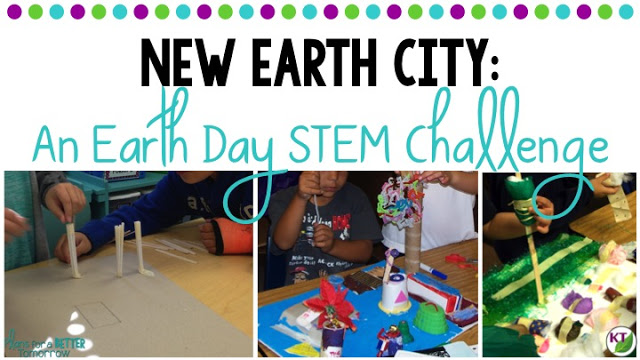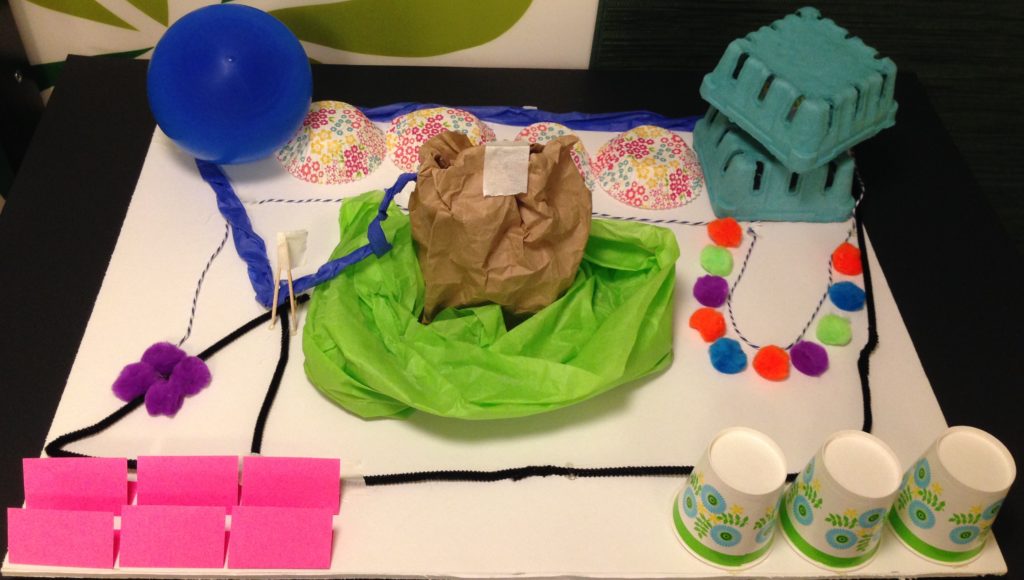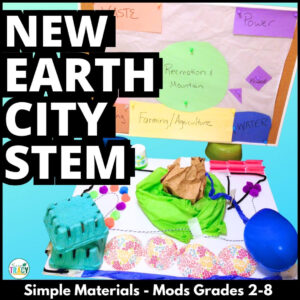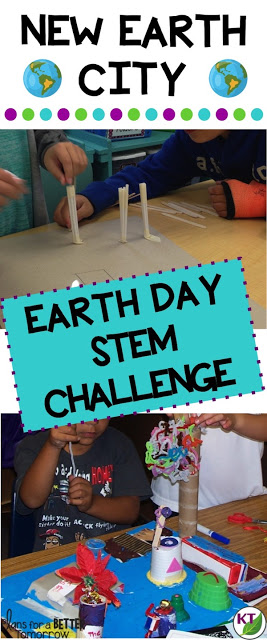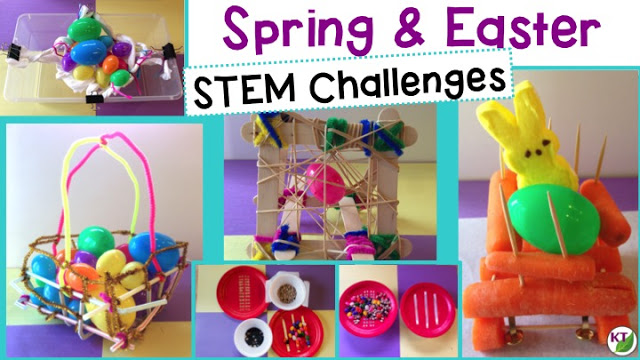Maybe Rome wasn’t built in a day, but New Earth City can be! This challenge is perfect for Earth Day, but it can really be used any time of the year. Fun fact: my master’s degree is in design-based learning, which shares many similarities with the engineering design process. This city-building challenge was my gateway drug into the STEM Challenge world. (More on that can be found here.)
Let’s get into New Earth City!
Premise
It is the year 2035, and Earth has
become overcrowded. The students are part of a pioneering crew tasked with
setting up the first city (New Earth City) on Planetopia, a fictional name for
a recently discovered Earth-like planet in a distant solar system. Part of the
mission is to set up the city to prevent or address the problems we are having
on Earth so we don’t repeat our errors on our new home planet. This
challenge is best done in teams or partners due to time and space constraints.
become overcrowded. The students are part of a pioneering crew tasked with
setting up the first city (New Earth City) on Planetopia, a fictional name for
a recently discovered Earth-like planet in a distant solar system. Part of the
mission is to set up the city to prevent or address the problems we are having
on Earth so we don’t repeat our errors on our new home planet. This
challenge is best done in teams or partners due to time and space constraints.
Video Walk-Through
This challenge can be pretty intense, or you can keep it simple. The easiest way for me to share the possibilities is to explain it in person. The second best option is to share it with you in video format! See below for all the info. you need. However, if you prefer to read, you’ll find the video transcribed at the end of this post.
Materials
One thing I always like to stress is that the suggested materials are often quite flexible. You can substitute, add, modify however you like. Basically, I like to provide a mix of mostly malleable materials with a few things for support (craft sticks, thicker cardboard, even straws). For a challenge like this, I often request students bring in “clean trash” for design materials (highlighting recycling for Earth Day!). We usually get cardboard tubes, bottle lids, and a host of other oddities that make for some interesting cities!

One thing you will need for this challenge is pieces of cardboard or foam board to act as the parcels of land on which to build New Earth City. I recommend at least 12 in. x 12 in. For younger students, larger boards are easier to work with. If you have the space for it, I’d get large foam boards at The Dollar Tree and cut them in half.
Materials List:
- 12 x 12 in. cardboard or foam board
- Serves as a parcel of Planetopia land. Feel free to go larger, but smaller is tough for students to manage.
- Plastic shopping bags (5)
- Pipe cleaners (12 – 24)
- Craft sticks (5 – 10)
- Paper or note cards
- Scissors
- Yarn or string
- Rulers
- Tape (24 – 26 in.)
- Data Measurement & Design Analysis handouts (included in resource)
Optional:
- Water or soda bottle lids
- Small cups
- Clay and/or foil
- Coffee stirrers
- Rubber bands
- Glue
- Markers
- Balloons
Criteria & Constraints
City planning can be intense! Urban planning is an entire field, after all. Thankfully, you have all the power to control how intense you want this Earth Day challenge to be for your kids.
The Criteria & Constraints List is key to any challenge. It’s the framework around what students must build and how. This is how we can adjust expectations and use a challenge for really any grade level we choose. You can find two examples from the resource with different levels of difficulty below.
The one on the left would be good for 2nd – 4th, and the one on the right works for 5th – 8th. You can add or delete items to tailor this Earth Day STEM challenge for your students.
For this challenge, I sometimes let the students help me make the list (this was how we did it in my master’s program), asking, “What types of things will we need in our new city to survive?” After a few minutes, whatever I wanted on the list that they haven’t suggested, I simply add. Always keep in mind the types of extension activities and lessons you want to tie in. If you want to work on surface area of various solids, require students have at least one of each 3D solid you want them to measure/calculate.
Measure Results
Students will measure and record their building sites. Then they’ll evaluate themselves check themselves against the Criteria & Constraints List.
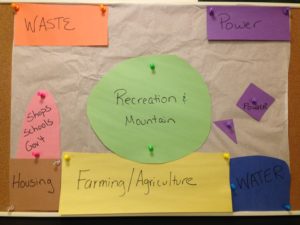
Extend
Extend with measurement and geometry activities based on distances from various points on student city designs, surface area & volume of buildings and structures, etc. You could have students research what is currently known about other Earth-like planets in the universe, and, of course, research what we can do to help our current planet survive for generations to come!
Another fun idea is to play up the pioneer angle, and have students keep journals and write letters home to “Old Earth” about their lives in New Earth City. (More ideas will be shared in the video and even more are in the resource.)
New to STEM Challenges?
If you’re wondering how to break down this, or any, STEM Challenge lesson in your classroom, check out The STEM Challenge Cycle.
Save Soooooo Much Time with the Resources!
PIN ME
Video Transcription
Hi, today we are doing a challenge that is near and dear to my heart. It is called New Earth City. It’s perfect for Earth Day, but truth be told, it’s really fine any time of year. The premise of this challenge is that it’s the year 2035 and Earth has run out of room. The students are being sent out as part of an exploratory group looking for a new planet to inhabit, when they come upon Planetopia, which is very Earth-like. In the same vein as our early explorers here, New World, New York, New Jersey, I call this New Earth City, but feel free to let your students name their cities whatever they like.
This challenge is actually adapted from one that I used as part of my master’s degree program in design-based learning. Now, I’m not going to get into all of that right now right here, but if you are interested in learning more about the Planetopia project, I will include a blog link in the description below, so check it out. Before I get ahead of myself, let’s check out the materials and the STEM Challenge Cycle. This is the STEM Challenge Cycle you should follow for every challenge. I’ve defined each step in another video. I’ve added a pop-in card to that video here, as well as a link in the description.
1:05
Now, all of your groups are going to need a parcel of land. The younger the students, the bigger that parcel should be. You could use an entire piece of foam board. I usually buy one and cut it in half, as I’ve done here. Older students can handle smaller parcels, like 12 by 12 or 16 by 16. Of course, it doesn’t need to be square. We’ve used a rectangle here and that worked just find. As always, the more variety in materials, the more diverse the end result will be. I don’t usually tell students ahead of time what we’ll be building, but I let them know, “We are doing a STEM Challenge this week. If you have any materials that you wouldn’t mind donating, that you do not expect to get back, bring them in.”
One more tip.
If your students are old enough to safely operate glue guns, go ahead and bring them out for this challenge. It is quite helpful. Now, for younger students, you don’t even want to mess with that. I just give them a full roll of masking tape and I don’t limit how much they can use. You’re going to see as I start going through this challenge that you could easily devote an entire week to this, but I know that you might only want to give it a day, so just pick and choose what you like based on the amount of time you want to spend.
2:02
For the criteria and constraints list, if you’re short on time, you will give the list to the students. If you have a little bit more time to spare, have the students help you generate the list by asking them, “What will you need on this new planet?” You should start fielding suggestions like places to live, places to work, schools, water sources, places to generate electricity. Now, this should only take a few moments, but whatever they don’t give you that you wanted, you’ll fill in the gaps. Maybe they didn’t say waste management. You’ll also fill in any other specifics that you know you’ll want to cover in your extension lessons. Maybe you know you’re going to be working on surface area. You don’t want them to build everything as rectangular prisms because they won’t get enough practice, so require cylinders and triangular prisms, and whatever it is you need.
For constraints, you can add in a few things like the waste management area must be smaller than the power generating area, or the housing can be no more than 1/4 of the entire land parcel, 1/4 of the city must be devoted to parks and recreation. Sometimes I also like to throw in an obstacle. As you see here, we have a mountain in the center of the parcel. because a constraint was that there is a 2 by 3 by 6-inch mountain in the middle of the parcel that they must build around. They can’t knock it down.
3:14
If you want to add difficulty, get a little bit more specific with the relationship between the structures. You can really almost create a puzzle. Some examples are waste management cannot be adjacent to any water source, and it must also be at least 6 inches from any housing. The area where you grow food must be 30% larger than the area of housing. You can really go down everything on the criteria list, places to live, work, schools, whatever’s on there, and assign a percentage or a fraction or a decimal. If your students are old enough to work with volume, you can even let them know that they need to provide housing for maybe 1,000 people, and one cubic centimeter is equivalent to 5 people, or 25 people. Choose a number.
3:56
If you’re going to be getting that specific, you’re probably going to want to give students a little bit of extra planning time. Ask them to think before they start building about how they can ensure that they devote the right amount of land to these different structures. To that end, it can be very helpful to provide students with scratch paper, butcher paper that’s the size of the land parcel, so they can sketch out ahead of time where they plan to put things before they start building. Now, the way you measure results will really vary based on the criteria and constraints you set up at the beginning of the challenge. Groups should go through the list item by item and check off whether or not they have met each and every criterion and constraint.
If you kept things simple, like the housing can be no more than 1/4 of the land parcel, you can really eyeball this and tell that we’ve met that constraint. If you added a lot of specific relational criteria or constraints, you’re going to need to give them some extra time to do their calculations. Again, it’s very helpful to have the butcher paper. You may want to also provide graph paper that they can overlay and estimate the surface area of the structure of each base. Also you may want to give them some base 10 blocks to help them estimate volume of different structures. You may even choose to provide calculators to help them get through the calculations in a timely manner.
5:04
What you see here is waste management, the mountain and parks and recreation, the town with shops and restaurants, housing, farming, water source, and energy. We’ve got solar panels, we’ve got some hydroelectric here, and we’ve got the power plant. The white and blue string represents the plumbing, and the black pipe cleaner represents power lines. The transportation in New Earth City is like a subway system, or you have to walk. You can see the footprint of each of those structures, other than the plumbing and the power lines, has been laid out here, and that’s going to make it a lot easier to calculate whether or not I’ve met my criteria and constraints. Now, this was actually laid out after the design and was used as a measurement activity that the groups sort of divided and conquered.
To extend on this challenge, have students do anything solar system or space exploration related. There are a lot of articles you can look up on Earth-sized planets that are in the Goldilocks zone. You can have students do close reads on those articles or do research. What is a Goldilocks zone? Have them research and explain what the Goldilocks zone means? You can have students use their New Earth Cities to do mapping activities or measurement and geometry. Even if you didn’t set up in the build for students to design housing for a certain population, you could after the fact have them figure out what is their population carrying capacity, based on what they built and based on some scale that you give them. Again, one cubic centimeter is equivalent to 20 people.
6:33
Once they’ve done that, you could let them know that word has gotten back to old Earth how awesome New Earth City is, and there’s an influx of 10,000 people coming that they need to provide housing for. If you want to tie in some ELA, you can have students compare and contrast New Earth City with their hometown. They could then use that to generate stories or journal entries about their new lives.
Woo, that was a lot. You now have the basics to do New Earth City in your class on your own, but as always, the resource is packed full of goodness for you, so take a second to check it out. This time saving resource contains everything you need, including modifications for use with second through eight graders. You’ll still need to gather the simple materials, of course, but the rest is ready and waiting. You’ll get Aligned Next Generation Science Standards, links to my STEM Challenge How-to videos to help you get the most from each challenge, and the New Earth City Materials list. In Teacher Tips, you’ll find premise and setup, how to increase or decrease difficulty through the criteria and constraints list, measuring results and cross-curricular extension suggestions.
7:28
You’ll find two levels of editable Criteria and Constraints lists so you can tailor the challenge to your students. To measure and record design size details, there are three leveled versions. For student design analysis handouts, there are two versions, four-page expanded room for response for younger students, and a two-page condensed space paper saver version. You’ll also find a set of group discussion questions. In the Extension Handouts, you’ll find measuring and classifying triangles practice, as well as math extension and process flow templates. This resource is available individually and as part of a discounted Mega STEM Challenge bundle. Links can be found in the description below the video.
I hope you and your students have a great time doing New Earth City. I’m going to be back next week with the first of the Summer STEM Challenges, so make sure you’re following or subscribe. Have a wonderful week. I will see you next time.

